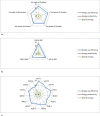Productivity, nutrient use efficiency, energetic, and economics of winter maize in south India
- PMID: 35862389
- PMCID: PMC9302768
- DOI: 10.1371/journal.pone.0266886
Productivity, nutrient use efficiency, energetic, and economics of winter maize in south India
Abstract
The winter maize area is rapidly spreading in south India in response to rising demand from the poultry and fish feed industries due to the absence of major environmental constraints. Further farmers' are using the winter environment to expand maize area and production. Hence there is immense potential to increase the area under winter maize cultivation. There were no planned field experiments to explore and optimize the right time of sowing and quantity of fertilizer to be added previously due to the presence of negligible winter maize area. Farmers used to cultivate maize as per their choice of sowing time with the application of a quantity of fertilizer recommended for rainy season maize. There were no efforts made towards working on economic analysis including energy budgeting. And hence the investigation was conducted with the objective to explore the optimal planting period and fertilizer levels for winter maize through economic and energy budgeting. Planting windows (1st week of October, 2nd week of October, 3rd week of October, 4th week of October, and 5th week of October) and fertility levels (100 percent recommended dose of fertilizer (RDF), 150 percent RDF, and 200 percent RDF) were used as factors in Factorial Randomized Complete Block Design (RCBD) with three replications. The present investigation revealed that significantly higher winter maize productivity was achieved from the first and second week of October planting along with the application of 200% RDF (recommended dose of fertilizer) followed by 150% RDF. Planting of winter maize during the first week of October recorded significantly higher grain yield (8786kg ha-1) and stover yield (1220 kg ha-1) and was found on par with sowing during the second week of October. Among fertility levels, significantly higher grain yield (8320 kg ha -1) and stover yield (1195 kg ha-1) was recorded with the application of 200% RDF and were found on par with the application of 150% RDF. Further interaction effect showed that higher dry matter production, more days for physiological maturity, higher accumulation of growing degree days, photothermal units, and heliothermal units were recorded from crops planted during the first and second week of October along with the application of either 200% or 150% RDF. However, higher nutrient use efficiency was recorded from the first and second week of October planted crop supplied with lower fertility level (100% RDF). Similarly, significantly higher net returns and gross returns, output energy, net energy, and specific energy were higher from crops planted during the first week of planting along with the application of 200% RDF. Whereas, energy use efficiency and energy productivity were higher with the first week of October planted crop applied with 100% RDF. From the overall interaction, it is recommended to plant winter maize during the first fortnight of October with the application of 150 percent RDF for sustaining higher maize productivity, energy output, and economics in the maize growing area of south India.
Conflict of interest statement
The authors have declared that no competing interests exist.
Figures




Similar articles
-
Redesigning and validation of fertilizer use in maize for variable plant densities in central rift valley and Jimma in Ethiopia.PLoS One. 2024 Jul 3;19(7):e0304004. doi: 10.1371/journal.pone.0304004. eCollection 2024. PLoS One. 2024. PMID: 38959254 Free PMC article.
-
Conservation tillage and fertiliser management strategies impact on basmati rice (Oryza sativa L): crop performance, crop water productivity, nutrient uptake and fertility status of the soil under rice-wheat cropping system.PeerJ. 2023 Nov 1;11:e16271. doi: 10.7717/peerj.16271. eCollection 2023. PeerJ. 2023. PMID: 37927793 Free PMC article.
-
Determining optimal mulching, planting density, and nitrogen application to increase maize grain yield and nitrogen translocation efficiency in Northwest China.BMC Plant Biol. 2020 Jun 19;20(1):282. doi: 10.1186/s12870-020-02477-2. BMC Plant Biol. 2020. PMID: 32560674 Free PMC article.
-
Macronutrient Management Effects on Nutrient Accumulation, Partitioning, Remobilization, and Yield of Hybrid Maize Cultivars.Front Plant Sci. 2020 Sep 2;11:1307. doi: 10.3389/fpls.2020.01307. eCollection 2020. Front Plant Sci. 2020. PMID: 32983197 Free PMC article.
-
Eco-physiology of maize crops under combined stresses.Plant J. 2024 Mar;117(6):1856-1872. doi: 10.1111/tpj.16595. Epub 2023 Dec 19. Plant J. 2024. PMID: 38113327 Review.
Cited by
-
Production risk and technical efficiency of dry-season vegetable farmers in the Upper East Region of Ghana.PLoS One. 2025 Feb 13;20(2):e0309375. doi: 10.1371/journal.pone.0309375. eCollection 2025. PLoS One. 2025. PMID: 39946341 Free PMC article.
-
Recent trends in nitrogen cycle and eco-efficient nitrogen management strategies in aerobic rice system.Front Plant Sci. 2022 Aug 25;13:960641. doi: 10.3389/fpls.2022.960641. eCollection 2022. Front Plant Sci. 2022. PMID: 36092421 Free PMC article. Review.
-
Normalized difference vegetation index sensor-based nitrogen management in bread wheat (Triticum aestivum L.): Nutrient uptake, use efficiency, and partial nutrient balance.Front Plant Sci. 2023 Apr 4;14:1153500. doi: 10.3389/fpls.2023.1153500. eCollection 2023. Front Plant Sci. 2023. PMID: 37082340 Free PMC article.
References
-
- USDA. Foreign agricultural service. World agricultural production. Circular series WAP 8–20. 2020; Online: https://apps.fas.usda.gov/psdonline/circulars/production.pdf
-
- IndiaAgristat. Area, production, and average yield, Directorate of Economics and Statistics, Department of Agriculture and Cooperation report, New Delhi. 2020; http://www.indiaagristat.com/
-
- Singh N. Rabi maize opportunities challenges, directorate of maize research, Pusa Campus, New Delhi -110 012, 2012 Technical Bulletin, No. 9:32.
-
- IndiaAgristat. Area, production, and average yield, Directorate of Economics and Statistics, Department of Agriculture and Cooperation report, New Delhi. 2019; http://www.indiaagristat.com/
-
- Vishwanatha VE. Integrated nutrient management in popcorn (Zea mays var. Everta). 2019; M. Sc. (Agri.) Thesis. Univ. Agric. Sci., Dharwad, India.
MeSH terms
Substances
LinkOut - more resources
Full Text Sources
Research Materials

